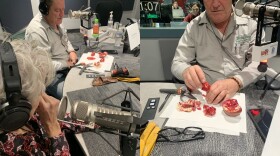Non-functional turf grass isn’t legal in lots of locations anymore, thank goodness. Green is nice, but does a green lawn in front of a bank or a lawyer’s office inspire more confidence than any other kind of planting? I don’t see how. Of course, individuals can choose their own home landscaping, even a lawn, as long as the irrigation system isn’t pouring our limited drinking water into storm drains.
Parks are so pleasant. There’s soft grass to walk on; dogs and children can frolic on it, but let’s be serious. Parks are spaces that many people can share.
For well over 100 years, unfortunately, a lush green lawn’s been the ideal landscape for virtually every private home. Even a tiny lawn is a mark of something. Have you ever watched someone mowing a patch of lawn that’s about 10 feet by 10 feet, using a gas powered mower? I have, but I restrained myself from asking - why not get a tiny sheep? It could eat the grass and add some fertilizer.
Why would someone living in the Mojave Desert not put in a landscape that fits the environment? When our local water supply is down about 100 feet, lawns are a terrible idea. When I speak with someone who tells me they have a lawn because they don’t like desert landscapes, I immediately jump into teaching mode.
Sometimes people complain about rocks – unpleasant to walk on for both people and their pets. There’s truth in that, but rocks aren’t the only option. So many ground covers can survive our desert climate, and some even tolerate being walked on. One of my personal favorites is called “silver carpet” – Dymondia margaretae. It’s got green and white leaves that closely resemble grass. It doesn’t grow much higher than two inches, so no need to mow. That’s not the only choice. The UNR extension website has a factsheet on viable alternatives to turfgrass. Definitely worth a look.
Dymondia margaretae
But people don’t just complain about rocks. There’s also the problem of spiky plants.
Quite a few plants do come with serious defenses, but let me point out that not all prickly plants are desert natives. If you’ve had a grapefruit tree, a palm, bougainvillea, even a pomegranate tree, you might have received a painful jab.
It’s easy to think that plants with spines and prickles are hostile to us. They’re not.
Desert plants often don’t have leaves, or have just a few tiny ones, so they rely on their green stems for growth. They’re well protected against anyone who might eat their green tissue. They can’t afford to have predators eat what little photosynthetic area they possess.
Cacti can be intimidating, for sure. Some have spines that would scare anybody. I have a few in my garden that I try to keep away at least 6 feet. Horticultural social distancing. Not all desert plants are cactuses, though. If you prefer the Latin, you can say ‘cacti’. I use both. Other desert plants, like agaves, also have thorns that you want to avoid.
Fortunately, not all desert plants come with their own armory.
Desert shrubs like cassia and dalea have beautiful flowers and no thorns! Low-growing flowering plants like desert marigold or dwarf achillea don’t grow much higher than 8 inches. The marigold is a short lived perennial, but it seeds itself like mad. Achillea, also known as Yarrow, is sometimes used medicinally, but I tried making it into a tea. Bad idea – that was the worst tasting tea ever!
So many plant selections can turn a dull lawn landscape into something exciting – with or without spines. And if you include lots of desert natives, you’ll find your water use can go way down!
For KNPR’s Desert Bloom, this is Dr. Angela O’Callaghan, Nevada’s Social Horticulture specialist.








